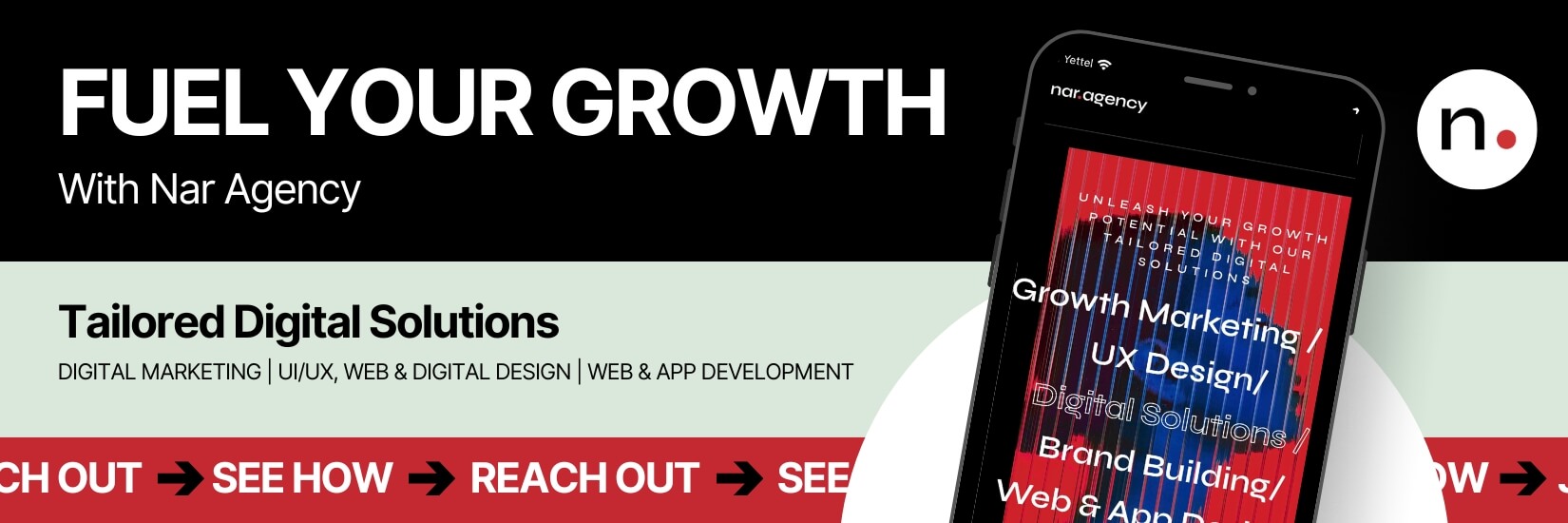Table of Contents
Brand awareness, the extent to which consumers recognize and recall your brand, is the foundation of all marketing efforts. It’s the first step in turning strangers into customers and customers into loyal advocates.
Consider this: 75% of consumers make purchases based on brand name alone (source: Nielsen).
This statistic underscores the power of brand awareness in driving consumer behavior.
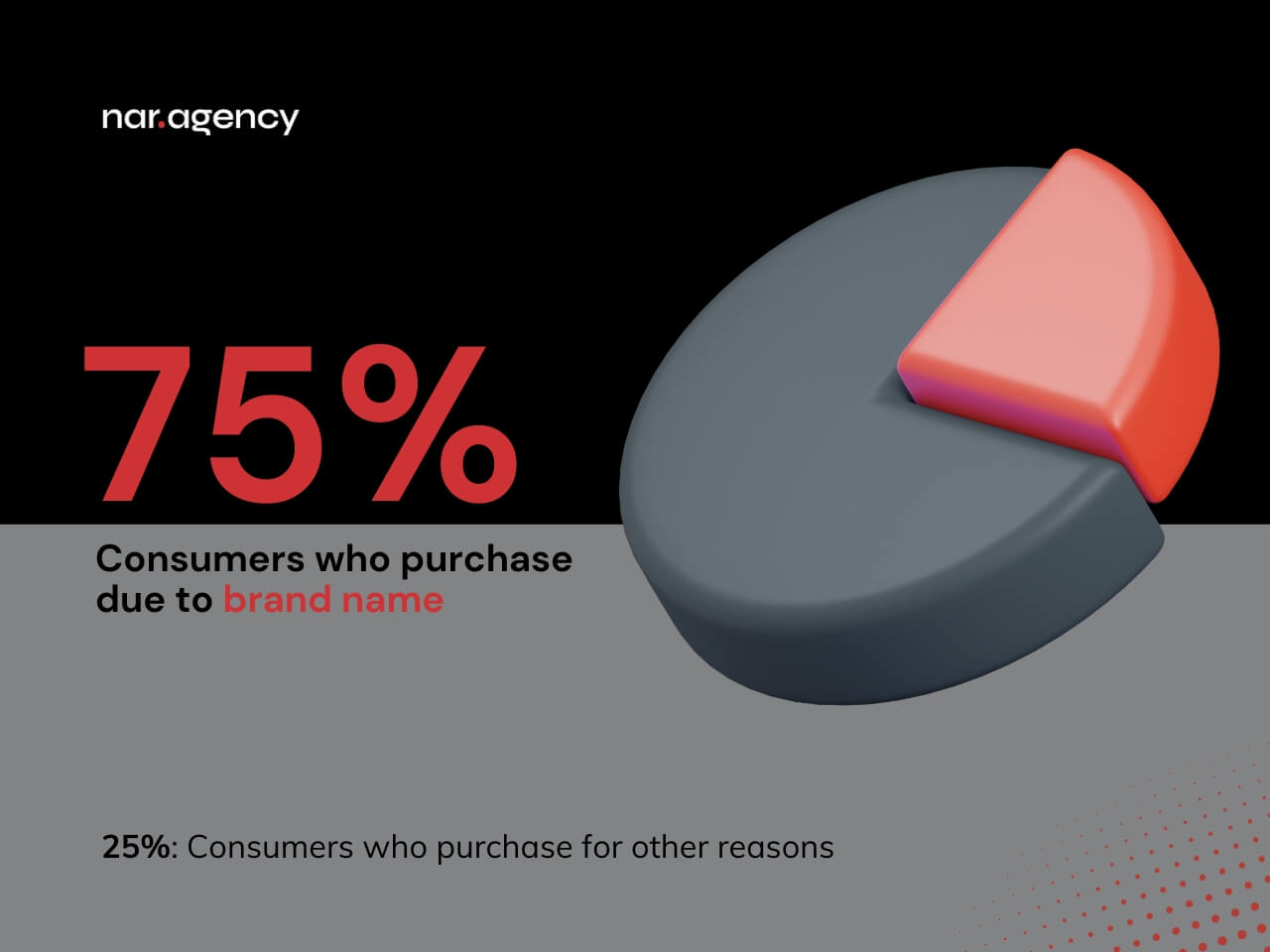
Moreover, strong brand awareness:
- Builds trust and credibility
- Increases customer loyalty
- Facilitates new product launches
- Enhances perceived value of products or services
- Improves marketing ROI
But here’s the kicker: with the average person exposed to thousands of brand messages daily, how do you ensure yours cuts through the noise?
That’s where this guide comes in. We’ve compiled an overview of 9 proven strategies that are not just theoretical, but battle-tested tactics that top brands are using right now to dominate their markets. From leveraging the latest in social media trends to mastering the art of local SEO, we’ll introduce you to methods that will:
- Boost your brand's visibility across multiple channels
- Create memorable experiences that stick in consumers' minds
- Measure and optimize your brand awareness efforts for maximum ROI
For each strategy, we’ll provide a brief overview and then link you to a comprehensive, in-depth article that goes deeper into implementation, best practices, and real-world examples. This approach allows you to get a bird’s-eye view of effective brand awareness tactics and then drill down into the areas most relevant to your business.
Whether you’re a startup looking to make your first big splash or an established company aiming to refresh your market presence, these strategies will give you the tools to skyrocket your brand recognition in 2024 and beyond.
Let’s go into our overview of these powerful strategies, and then you can explore each one in detail.
What is Brand Awareness?
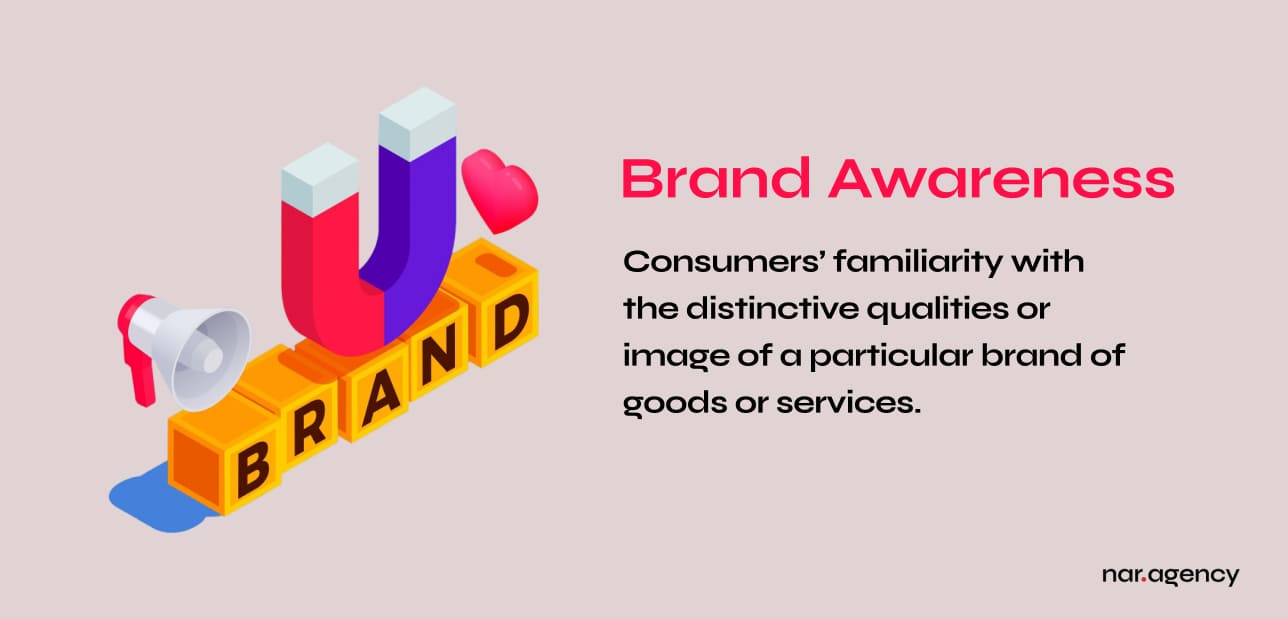
Brand awareness is more than a logo or recalling a catchy jingle. It’s the foundation of your brand’s relationship with consumers, the first step in a customer journey that can lead to loyal customers and brand advocates.
Brand Awareness Definition
Brand awareness refers to the extent to which consumers are familiar with the distinctive qualities or image of a particular brand of goods or services. It’s the ability of potential customers to not just recognize your brand, but to associate it with specific attributes, values, or solutions.
Types of Brand Awareness
Brand Recall: This is when consumers can retrieve your brand from memory when given a product category or need as a cue. For example, thinking of “Nike” when considering athletic shoes.
Brand Recognition: This occurs when consumers can identify your brand when presented with it. It’s the “Oh, I’ve heard of them!” moment.
Top-of-Mind Awareness: This is the holy grail of brand awareness. It’s when your brand is the first one consumers think of in a particular category. Think “Kleenex” for tissues or “Google” for search engines.
How Brand Awareness Works in Consumer Decision-Making
Brand awareness plays a crucial role at every stage of the consumer journey:
Problem Recognition: Consumers are more likely to identify a need or problem that your brand can solve if they’re aware of your offerings.
Information Search: Aware consumers are more likely to include your brand in their consideration set when researching solutions.
Evaluation of Alternatives: Strong brand awareness can tip the scales in your favor when consumers are comparing options.
Purchase Decision: Consumers tend to choose familiar brands, especially when making quick decisions or when the stakes are low.
Post-Purchase Behavior: Positive experiences with a known brand can lead to stronger loyalty and word-of-mouth recommendations.
In essence, brand awareness is about occupying valuable real estate in your target audience's mind. It's the difference between being a forgettable option and being the go-to choice in your category.
As you go through this guide, you’ll discover how to not just create brand awareness, but to leverage it for tangible business results. Up next, we’ll explore why brand awareness matters and the concrete benefits it brings to your business.
Why Brand Awareness Matters
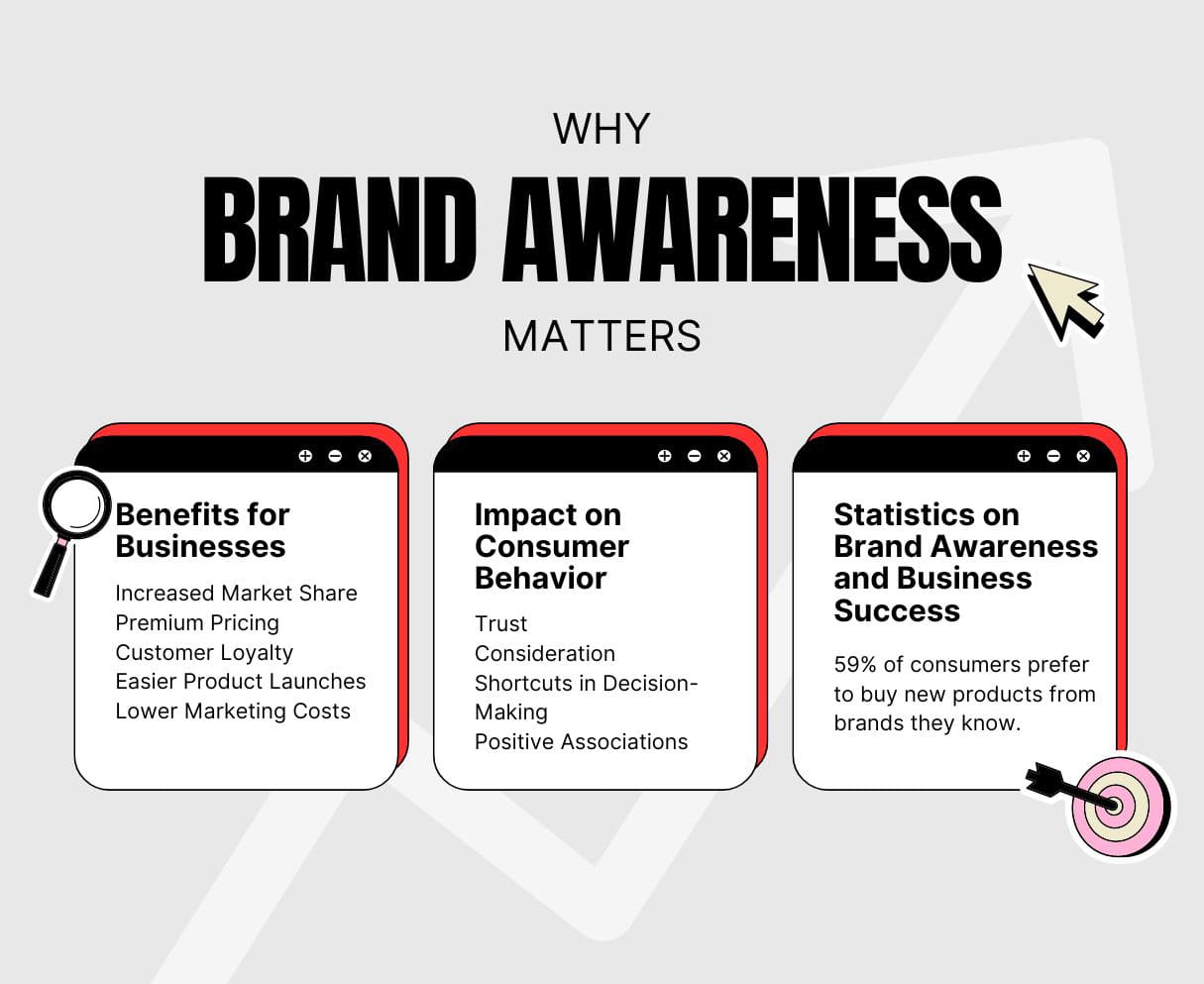
Brand awareness isn’t just a vanity metric—it’s a powerful driver of business success. Here’s why it’s important for you:
Benefits for Businesses:
Increased Market Share: Higher brand awareness often translates to a larger slice of the market pie.
Premium Pricing: Well-known brands can command higher prices as consumers associate them with quality and reliability.
Customer Loyalty: Familiar brands enjoy higher customer retention rates and repeat purchases.
Easier Product Launches: New products from known brands face less resistance in the market.
Lower Marketing Costs: Strong brand awareness reduces the need for continuous heavy advertising.
Impact on Consumer Behavior:
Trust: Consumers are more likely to trust brands they recognize, reducing perceived risk in purchasing decisions.
Consideration: Aware consumers automatically include your brand in their consideration set when making purchase decisions.
Shortcuts in Decision-Making: In low-involvement purchases, consumers often choose the brand they know best.
Positive Associations: Strong brand awareness often comes with positive attributes associated with the brand.
Statistics on Brand Awareness and Business Success:
59% of consumers prefer to buy new products from brands they know. (Nielsen)
Consistent brand presentation across all platforms increases revenue by up to 23%. (Lucidpress)
77% of consumers make purchases based on a brand name. (Crowdspring)
Brands that are consistently presented are 3.5 times more likely to enjoy excellent brand visibility than those with inconsistent brand presentation. (Demand Metric)
These statistics underscore the tangible impact of brand awareness on a company’s bottom line. By investing in brand awareness, you’re not just making your brand more recognizable—you’re laying the groundwork for sustained business growth and success.
In the next section, we’ll explore how to measure brand awareness, ensuring your efforts are translating into real results.
How to Measure Brand Awareness
Measuring brand awareness is crucial for understanding the effectiveness of your marketing efforts and guiding future strategies. Here are key metrics, tools, and methods to quantify your brand’s presence in the market:
Key Metrics and KPIs:
Brand Recall: Percentage of consumers who can name your brand unprompted when asked about your industry.
Brand Recognition: Percentage of consumers who recognize your brand when presented with it.
Share of Voice: Your brand’s visibility compared to competitors in media, social platforms, and search results.
Website Traffic: Particularly direct traffic and branded search traffic.
Social Media Followers and Engagement: Growth in followers, likes, shares, and comments.
Search Volume: Number of branded searches for your company name or products.
Tools and Methods for Measurement:
Surveys: Use tools like SurveyMonkey or Google Forms to directly ask consumers about brand familiarity.
Social Listening Tools: Brandwatch or Mention to track brand mentions and sentiment across social media.
Google Analytics: Monitor direct traffic and branded search traffic to your website.
Google Trends: Compare search interest in your brand over time and against competitors.
Brand Tracking Software: Solutions like YouGov, BrandIndex or Latana for comprehensive brand health monitoring.
Social Media Analytics: Native tools on platforms like Facebook Insights or Twitter/X Analytics.
SEO Tools: SEMrush or Ahrefs to track branded keyword volume and rankings.
Importance of Tracking Progress:
Measure ROI: Quantify the return on your brand awareness investments.
Identify Trends: Spot patterns in awareness levels to inform strategy.
Competitive Insights: Understand your position relative to competitors.
Campaign Effectiveness: Determine which marketing efforts are moving the needle.
Guide Resource Allocation: Direct budget and efforts to the most effective channels.
Regular measurement allows you to set benchmarks, track improvements, and make data-driven decisions to enhance your brand awareness strategies. Remember, improvements in brand awareness often precede increases in sales and market share.
In the next section, we’ll explore the Brand Awareness Funnel and strategies to move customers through each stage.
The Brand Awareness Funnel
The Brand Awareness Funnel is a crucial concept in understanding how consumers move from complete unfamiliarity with your brand to becoming loyal advocates. This journey typically consists of four key stages:
Unfamiliar
Recognition
Recall
Top of Mind
1. Unfamiliar Stage
At the Unfamiliar stage, potential customers have no knowledge of your brand. Your primary goal here is to simply get on their radar. This might involve broad-reach advertising, content marketing, or social media campaigns designed to introduce your brand to a wide audience.
2. Recognition stage
As consumers move to the Recognition stage, they can identify your brand when presented with it. This is where consistent branding across all touchpoints becomes crucial. From your logo to your messaging, every interaction should reinforce your brand identity.
3. Recall stage
The Recall stage is where your brand awareness efforts really start to pay off. Here, consumers can bring your brand to mind without prompts when thinking about your product category. This is often the result of repeated exposure and positive associations built over time.
4. Top of Mind stage
Finally, the coveted Top of Mind stage is where your brand is the first one consumers think of in your category. Achieving this status requires not just awareness, but also a strong emotional connection and perceived value that sets you apart from competitors.
Moving customers through these stages requires a strategic approach tailored to each level of awareness. The type of content and messaging that resonates with someone unfamiliar with your brand will differ significantly from what appeals to a customer who already recognizes and recalls your brand.
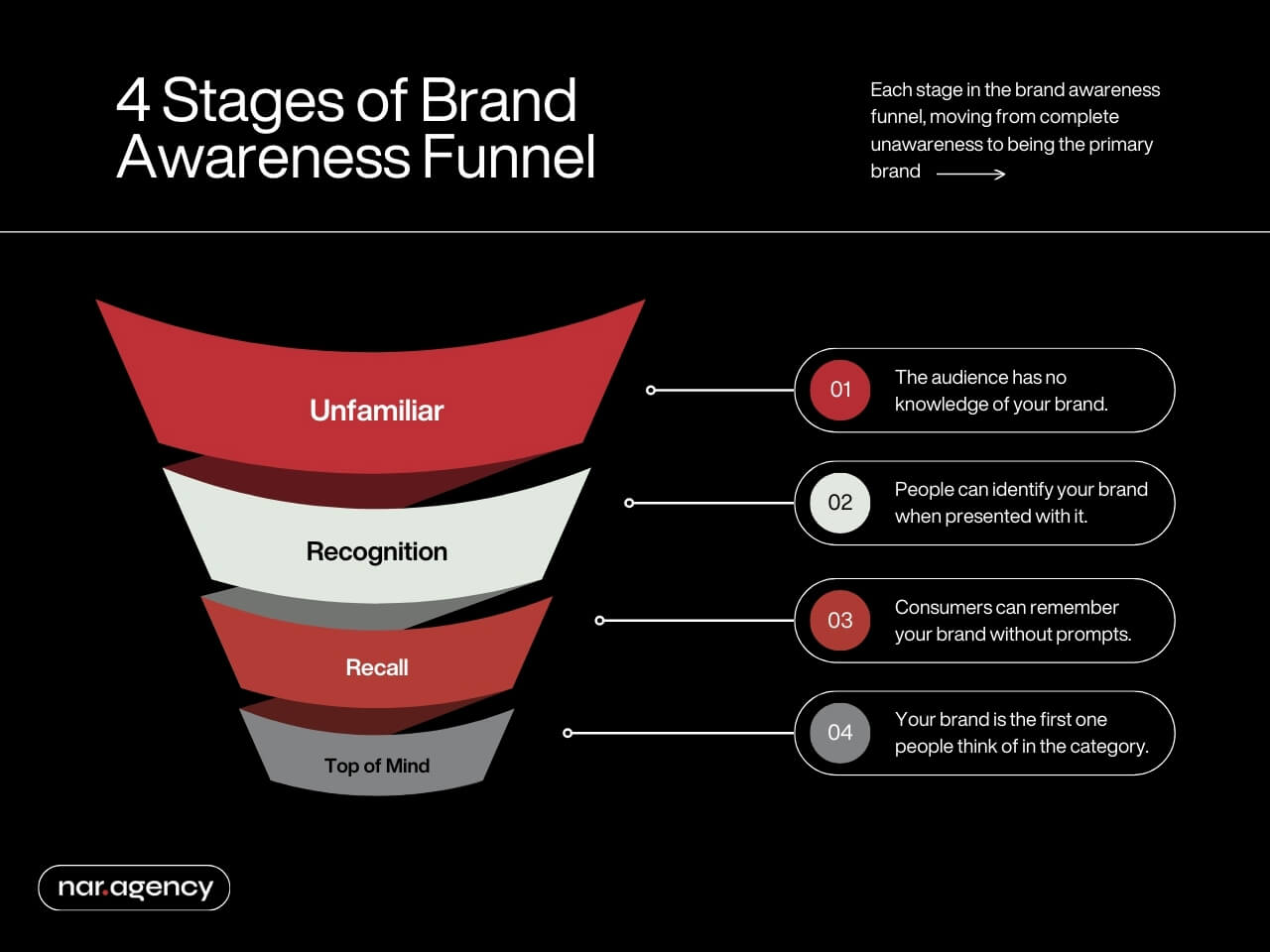
Curious about the specific types of content that work best at each stage of the funnel? We’ve got you covered. Check out our in-depth guide on Marketing Funnel Content Strategies for actionable insights on crafting high-converting content for every stage of the customer journey.
By understanding and leveraging the Brand Awareness Funnel, you can create more targeted, effective strategies that guide potential customers from initial awareness all the way to brand advocacy. In the next section, we’ll go into nine proven strategies to boost your brand awareness across all stages of this funnel.
9 Proven Strategies to Boost Brand Awareness
Now that we understand the Brand Awareness Funnel, let’s explore an overview of nine powerful strategies to elevate your brand’s visibility and recognition. Each of these strategies has been proven effective across various industries and can be tailored to suit your specific brand needs.
We’ll provide a brief introduction to each, and you can click through to read comprehensive articles on the strategies that interest you most.
Social Media Brand Awareness: 7 Hacks to Go Viral in 2024
Social media is a powerhouse for brand awareness. Discover tactics to make your brand stand out and potentially go viral on platforms like Instagram, TikTok, and LinkedIn.Content Marketing for Brand Recognition: Secrets Big Brands Don’t Want You to Know
Content is king, but not all content is created equal. Uncover the hidden strategies top brands use to create content that boosts recognition and keeps audiences coming back for more.Paid Advertising ROI: Double Your Brand Awareness (Without Doubling Your Budget)
Learn how to maximize your advertising spend with targeted campaigns that dramatically increase brand visibility without breaking the bank.Introverted Founder? How to Build Your Brand at Industry Events
Events offer unparalleled opportunities for face-to-face brand building. Find out how to make lasting impressions and valuable connections, regardless of your networking comfort level.The Referral Program Flywheel: How to Build a System for Sustainable Growth
Word-of-mouth remains one of the most powerful forms of marketing. Explore strategies to transform satisfied customers into enthusiastic brand ambassadors.Brand Collaboration Guide: 10 Unexpected Partnerships That Exploded Awareness
Strategic partnerships can skyrocket your brand awareness. Discover surprising collaboration ideas that have led to massive brand exposure for companies across various sectors.Email Marketing Mastery: Craft Subject Lines That Boost Open Rates by 50% [EXAMPLES+TEMPLATES]
Email might be old school, but it’s far from obsolete. Learn techniques to create compelling email campaigns that significantly increase brand recognition and engagement.Local SEO Domination: Outrank Your Competitors in 30 Days or Less
For businesses with a local focus, dominating local search results is crucial. Uncover strategies to quickly improve your local SEO and outshine nearby competitors.Brand Awareness Metrics: The Only 3 KPIs That Actually Matter in 2024
Measuring brand awareness is essential for refining your strategies. Learn which key performance indicators truly reflect your brand’s growing recognition and influence.
Implementing Brand Awareness Strategies

Now that we’ve explored nine powerful strategies for boosting brand awareness, it’s time to focus on implementation.
Factors to Consider:
Budget: Your financial resources will significantly influence which strategies you can pursue and to what extent. Some tactics, like social media marketing, can be effective even with limited budgets, while others, such as large-scale advertising campaigns, may require substantial investment.
Target Audience: Understanding your audience is crucial. Different demographics respond to various channels and messaging styles differently. For instance, younger audiences might be more receptive to TikTok campaigns, while professional audiences might be better reached through LinkedIn.
Industry: Your industry context matters. B2B companies might find more value in industry events and content marketing, while B2C brands might benefit more from social media and community engagement strategies.
Brand Personality: Your brand’s voice and values should consistently shine through in all awareness efforts. A playful, youth-oriented brand might thrive on social media challenges, while a more serious, professional brand might focus on thought leadership content.
Creating a Balanced Brand Awareness Plan:
Diversification is key. Don’t put all your eggs in one basket. Instead, create a mix of strategies that cover different stages of the Brand Awareness Funnel. This approach ensures you’re both introducing your brand to new audiences and reinforcing recognition with those already familiar with you.
Start with a core set of strategies that align best with your resources and audience. As you gain traction and gather data, gradually expand your efforts. Remember, consistency across all channels is crucial for building strong brand recognition.
Tips for Successful Implementation:
Set Clear Goals: Define what success looks like for each strategy. Is it increased website traffic? More social media followers? Higher engagement rates?
Create a Timeline: Develop a realistic schedule for rolling out your strategies. Some, like social media campaigns, can start quickly, while others, like developing a content marketing plan, may take more time to implement.
Assign Responsibilities: Ensure each aspect of your brand awareness plan has a dedicated owner or team responsible for its execution.
Monitor and Adjust: Regularly review the performance of your strategies. Be prepared to pivot or adjust your approach based on the results you’re seeing.
Integrate Your Efforts: Look for ways your strategies can complement each other. For example, how can your social media efforts support your content marketing strategy?
Stay Authentic: As you implement various strategies, ensure they all align with your brand’s core values and messaging. Authenticity builds trust and reinforces brand recognition.
By carefully considering these factors, creating a balanced digital strategy, and following these implementation tips, you’ll be well-positioned to execute your brand awareness strategies effectively. Remember, building brand awareness is a marathon, not a sprint. Patience, consistency, and adaptability are key to long-term success.
Common Brand Awareness Mistakes to Avoid
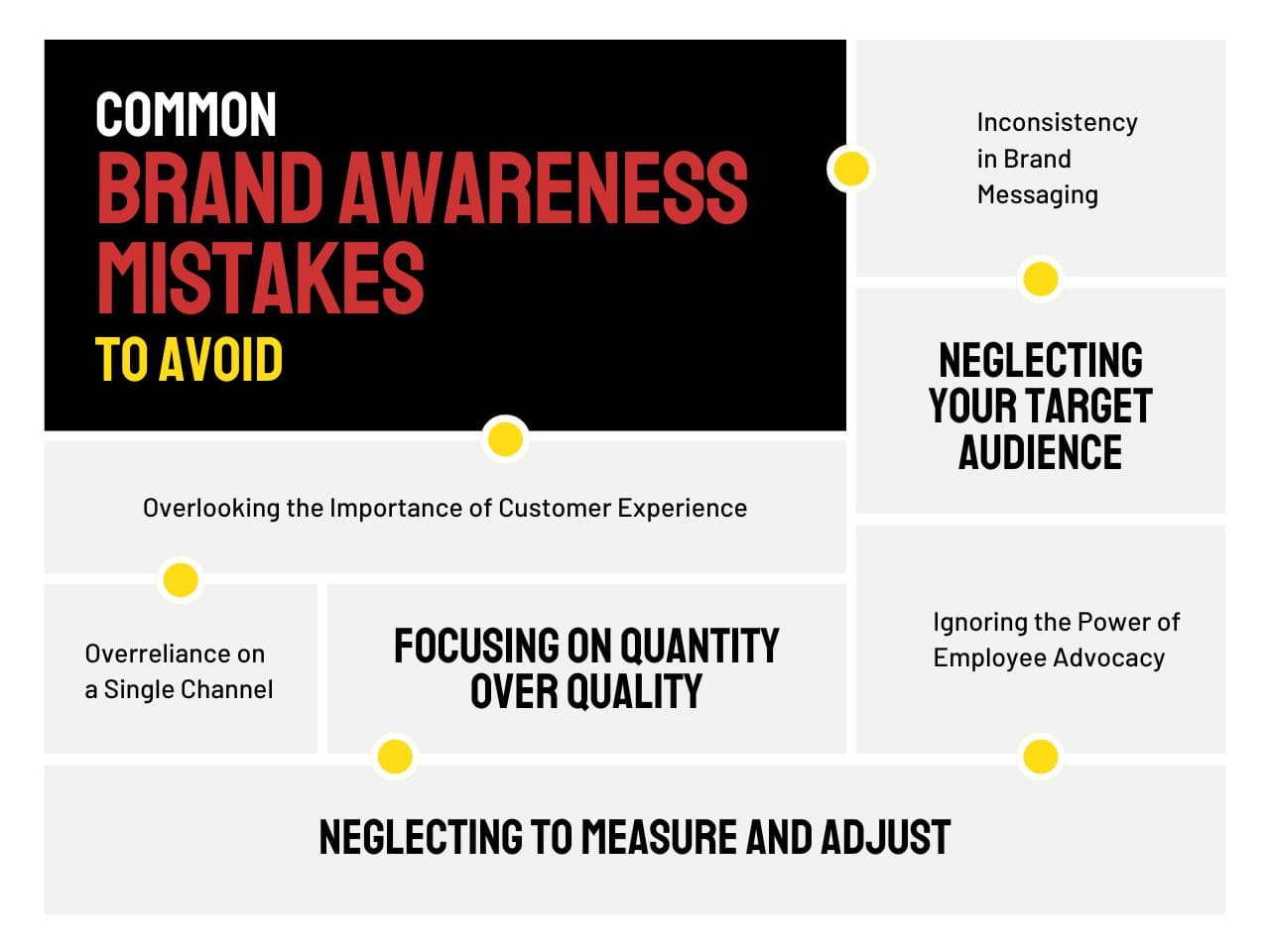
Even with the best intentions, brands can stumble in their quest for increased awareness. Recognizing and avoiding these common pitfalls can save you time, resources, and potential brand damage. Let’s explore some of the most frequent missteps and how to overcome them.
Inconsistency in Brand Messaging
One of the most critical errors is inconsistent brand messaging across different channels. When your brand voice, visual identity, or core values fluctuate, it confuses your audience and dilutes your brand’s impact. To combat this, develop clear brand guidelines and ensure all team members and external partners adhere to them rigorously. Regular brand audits can help maintain consistency and identify any deviations quickly.
Neglecting Your Target Audience
Another common mistake is trying to appeal to everyone, resulting in generic messaging that resonates with no one. Remember, effective brand awareness is about being memorable to the right people, not just visible to all. Invest time in understanding your target audience’s preferences, behaviors, and pain points. Tailor your brand awareness efforts to speak directly to these insights, creating more meaningful connections.
Overreliance on a Single Channel
While it’s tempting to focus all your efforts on a channel that seems to be working well, this approach can be risky. Platforms and audience preferences change over time. Diversifying your brand awareness strategies across multiple channels not only reaches a broader audience but also provides resilience against platform-specific changes or shifts in consumer behavior.
Ignoring the Power of Employee Advocacy
Many brands overlook their most powerful brand ambassadors: their employees. Engaged employees can significantly amplify your brand message through their personal networks. Encourage and empower your team to share brand content, experiences, and values. Provide them with the tools and guidelines to do so effectively, turning your workforce into a potent brand awareness force.
Focusing on Quantity Over Quality
In the rush to increase brand visibility, some companies prioritize the quantity of content or interactions over quality. This can lead to a flood of mediocre content that fails to engage or, worse, turns off potential customers. Instead, focus on creating high-quality, valuable content that truly reflects your brand’s expertise and values. It’s better to have fewer, more impactful brand touchpoints than numerous forgettable ones.
Neglecting to Measure and Adjust
Failing to track the effectiveness of your brand awareness efforts is like driving with your eyes closed. Without proper measurement, you can’t know what’s working and what isn’t. Implement robust tracking mechanisms for all your brand awareness initiatives. Regularly analyze this data and be prepared to pivot your strategies based on the insights you gain. Remember, brand awareness is an ongoing process that requires continuous refinement.
Overlooking the Importance of Customer Experience
Brand awareness isn’t just about getting your name out there; it’s about the associations people have with your brand. Neglecting customer experience can lead to increased awareness, but for all the wrong reasons. Ensure that every interaction with your brand, from social media engagement to customer service, aligns with the image you’re trying to project. A positive customer experience turns casual observers into brand advocates.
By being aware of these common mistakes and actively working to avoid them, you can create more effective, impactful brand awareness strategies. Remember, building brand awareness is a journey of continuous learning and adaptation. Embrace the challenges as opportunities to refine your approach and strengthen your brand’s position in the market.
Don’t be the Industry Wallflower
Find Your Brand's Hidden Potential
in One Power-Packed Session
⏱️ 30-minute brand awareness blitz
🎯 Uncover your unique edge
💡 Walk away with a battle plan
Measuring ROI of Brand Awareness Campaigns
Quantifying the return on investment (ROI) for brand awareness campaigns can be challenging, as the benefits are often intangible and long-term. However, it’s crucial to demonstrate the value of these efforts to stakeholders and guide future strategies. Let’s explore how to connect awareness to business outcomes and calculate the value of increased brand awareness.
Connecting Awareness to Business Outcomes
The first step in measuring ROI is understanding how brand awareness translates into tangible business results. While the path isn’t always direct, increased awareness typically leads to:
- Higher Website Traffic: As more people become familiar with your brand, you should see an uptick in direct traffic to your website. Monitor changes in your traffic sources, paying particular attention to direct and branded search traffic.
- Increased Social Media Engagement: Greater brand awareness often results in more followers, likes, shares, and comments on your social media platforms. Track these metrics over time to gauge the impact of your awareness campaigns.
- More Inbound Inquiries: As your brand becomes more recognized, you may notice an increase in unsolicited inquiries from potential customers, partners, or even media outlets. Keep a record of these inquiries and their sources.
- Improved Conversion Rates: Familiarity breeds trust. As your brand awareness grows, you may see higher conversion rates on your website or in your sales funnel. Compare conversion rates before and after awareness campaigns.
- Lower Customer Acquisition Costs: With increased brand recognition, your marketing efforts may become more efficient. Monitor your customer acquisition costs over time to see if they decrease as awareness increases.
Calculating the Value of Increased Brand Awareness
While there’s no one-size-fits-all formula for calculating brand awareness ROI, here are some approaches to consider:
- Brand Awareness Lift Studies: Conduct surveys before and after awareness campaigns to measure the increase in brand recognition or recall. Assign a monetary value to each percentage point increase based on your market size and average customer value.
- Attribution Modeling: Use multi-touch attribution models to understand how brand awareness activities contribute to conversions. This can help you assign value to top-of-funnel activities that may not directly lead to sales but play a crucial role in the customer journey.
- Comparative Analysis: Compare the performance of regions or market segments where you’ve run awareness campaigns against those where you haven’t. The difference in sales or market share can indicate the value of increased awareness.
- Lifetime Value Increase: Monitor whether customers acquired during or after awareness campaigns have a higher lifetime value. This can indicate the long-term impact of brand awareness on customer relationships.
- Share of Voice Analysis: Track your brand’s share of voice in your industry and correlate increases with business performance. Tools like social listening platforms can help quantify your brand’s presence in online conversations.
Remember, measuring brand awareness ROI is both an art and a science. It requires a combination of data analysis, market research, and sometimes, educated estimations. The key is to establish consistent metrics and measurement processes that align with your specific business goals and industry context.
By demonstrating the tangible impacts of brand awareness efforts, you can justify continued investment in these crucial activities. Moreover, this data-driven approach allows you to refine your strategies continuously, focusing resources on the awareness tactics that drive the most value for your business.
Conclusion
Brand awareness isn’t just some fancy marketing term – it’s the key to getting your business noticed and remembered. We’ve covered a lot of ground here, from understanding what brand awareness really means to exploring strategies that actually work.
The bottom line? Building brand awareness takes time and effort, but it’s worth it. Whether you’re just starting out or looking to take your brand to the next level, there’s something in these strategies for everyone.
Remember, it’s not about being everywhere – it’s about being where your audience is, with a message that sticks. Start with one or two strategies that make sense for your brand, and go from there. Keep an eye on what’s working, adjust when needed, and don’t be afraid to get creative.
Your brand has something unique to offer, just make sure people know about it.
Share :

